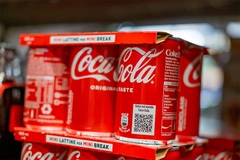Reduced & Royal Greenland form partnership to develop premium taste solutions from prawn side streams
Danish biotech company Reduced and Royal Greenland, one of the world’s largest seafood suppliers, have inked an agreement to develop value from prawn side streams. The partnership aims to transform prawn processing side streams into clean label, high-performance taste solutions slated for future commercialization.
The partnership applies Reduced’s proprietary fermentation-based platform to prawn shells and heads, which represent nearly half of the cold-water prawn biomass. Traditionally used for low-cost food and feed ingredients, this material is now being upcycled into a natural prawn concentrate with “exceptional flavor and broad application potential.”
Royal Greenland, certified by the Marine Stewardship Council (MSC) for its sustainable cold-water prawn fisheries, brings scale, supply chain credibility, and a clear route to market to the partnership.
The collaboration with Reduced’s fermentation expertise shows how circular processing can turn side streams with great potential into high-value taste solutions, demonstrating both strong commercial potential and a clear path toward more resource-efficient seafood production.
Food Ingredients First speaks with Emil Munck de Voss, CEO and co-founder of Reduced, and Kristian Ottesen, director of Royal Greenland, who shed light on the new partnership and address how it might impact the future of food taste solutions.

What does this collaboration reveal about the potential for circular processing in the broader food sector?
Munck de Voss: It shows that circular processing can create tangible commercial value when producers and fermentation specialists work together. By converting a low-value side stream into a high-performance ingredient without major plant changes, the partnership provides a practical blueprint other categories can adopt.
Provenance stays intact within Royal Greenland’s supply network, which enhances traceability and supports credible ESG reporting. For our existing product line, we provide CO₂e certification to document the impact of circular processing, and the same level of transparency will follow with this co-developed product, giving complete visibility on carbon emissions.
The outcome is sensory-first, meets clean label expectations, and is built for real manufacturing environments, which makes circularity deliverable at scale rather than aspirational.
Ottesen: I can only answer for the seafood industry; however, at Royal Greenland, sustainability and circularity are not just a strategic priority but a deeply rooted commitment shaped by our Arctic heritage and global responsibility. We operate a fully integrated value chain that emphasizes responsible fisheries, certified by independent third parties where possible, and guided by scientific advice to ensure the long-term viability of marine resources. Our production philosophy centers on maximizing resource utilization — transforming every part of the catch into high-quality products — while minimizing environmental impact through circular handling of non-renewable materials and reducing energy and water consumption across our facilities.
We also actively contribute to developing sustainable fisheries through partnerships like Sustainable Fisheries Greenland and pursue MSC certification where feasible, recognizing both the ecological and market value of certified operations. Our sustainability strategy aligns with four of the UN’s Sustainable Development Goals, reflecting our broader commitment to social responsibility, including education, occupational health, and community development in Greenland and beyond. We see the importance of applying new processing methods in order to increase the value of side streams further; hence, this collaboration is a key measure for us and the industry to explore new potentials and further improve the focus on resource utilization.
How can food manufacturers integrate this prawn concentrate into product lines?
Munck de Voss: Our prawn concentrate is designed to operate as a clean label crustacean flavor base that can either replace or reduce the need for compounded seafood flavors, yeast extracts, or lengthy stock reductions. We have seen food manufacturers use our ingredients to improve flavor and taste profiles significantly, reduce reliance on costly raw materials, and simplify labels. This new collaboration aims to deliver the same advantages in a prawn-based format, combining taste with clean label functionality.
In practice, suppliers might incorporate it as a top-note and umami driver in soups, sauces, marinades, noodle broths, fillings, and dressings. It performs well when added post-cook and pre-fill in liquid applications, or as a pre-blended component in marinades, snacks, and fillings for ready meals.
 This natural prawn concentrate boasts “exceptional flavor and broad application potential.”Because it is fully declarable as a prawn or shrimp concentrate with no additives or flavorings, it aligns with clean label objectives while supporting salt reduction through natural umami. Standard crustacean allergen labeling applies, and allergen segregation is straightforward to manage within existing Quality Assurance systems. The concentrate will first be launched in a liquid format, followed by a powdered version to broaden its applications and market reach.
This natural prawn concentrate boasts “exceptional flavor and broad application potential.”Because it is fully declarable as a prawn or shrimp concentrate with no additives or flavorings, it aligns with clean label objectives while supporting salt reduction through natural umami. Standard crustacean allergen labeling applies, and allergen segregation is straightforward to manage within existing Quality Assurance systems. The concentrate will first be launched in a liquid format, followed by a powdered version to broaden its applications and market reach.
What techniques are used to upcycle prawn side streams, and how can food technologists replicate or scale these methods?
Munck de Voss: The process combines bioprocessing with traditional fermentation techniques to fully unlock and highlight the inherent flavors of the side stream. By using koji fermentation and targeted enzymatic steps, we can bring out clean, natural crustacean notes that translate directly into culinary performance.
The aim is to deliver an outstanding sensory experience and address common pain points in NPD and reformulation, such as clean label requirements, managing cost, salt reduction, and versatility across applications.
Because the platform is versatile, food technologists can adapt the approach to other seafood or agricultural by-products, scaling it within existing production environments and extending the model to new categories without significant infrastructure changes.
So far, we have successfully integrated four major side streams from the food and agriculture sector into commercialized products using our platform. These examples demonstrate that, with the right raw materials and process design, side streams can be transformed into scalable, high-value ingredients that directly address the industry’s key challenges.
Not every side stream is equally suited for this kind of upcycling. Still, by working closely with industry partners, we can identify those with the most significant potential and develop solutions that work both technically and commercially.
How do you anticipate this upcycled prawn ingredient will perform in global taste ingredient markets, particularly Europe and North America?
Munck de Voss: We expect strong interest from buyers who prioritize superior taste, clean label, and responsible sourcing. In Europe and North America, food manufacturers of soups, sauces, chilled meals, and noodle bases are looking to move away from additive-heavy formulations while maintaining depth of flavor.
This ingredient offers a clear point of difference: single-origin crustacean character, straightforward food-based labeling, and a robust sourcing story supported by Royal Greenland’s supply chain. Royal Greenland’s established industry and foodservice channels strengthen the route to market and help accelerate trials and co-development with customers. Performance will ultimately be judged by sensory outcome and cost-in-use, and early prototypes indicate a favorable profile on both.
Ottesen: By upcycling nutrient-rich prawn side-streams into a high-value taste ingredient, we are addressing both environmental responsibility and evolving consumer preferences. We anticipate strong market interest in Europe and North America, where demand for clean label, traceable, and eco-conscious ingredients is accelerating. The flour’s fermentation-enhanced umami profile and its nutritional benefits make it ideal for use in savory foods, snacks, and functional nutrition. This product exemplifies our commitment to circular resource utilization and Arctic sustainability — delivering flavor, function, and responsibility in one ingredient.
How do you envision the use of this ingredient evolving in other food applications?
Munck de Voss: In ready meals, the concentrate can elevate seafood dishes such as risotto, paella, chowders, ramen kits, and dumpling fillings with a small dosage, improving flavor consistency across factories and seasons. In snacks, it can be carried in oil phases for crackers or extruded snacks to deliver a distinctive marine note without artificial flavorings. For plant-based and hybrid products, it could also provide an authentic crustacean top note that enhances the overall profile of seafood analogs while keeping labels simple. Additionally, there is clear potential for cross-industry collaborations, such as seafood-based flavor solutions in pet foods.















